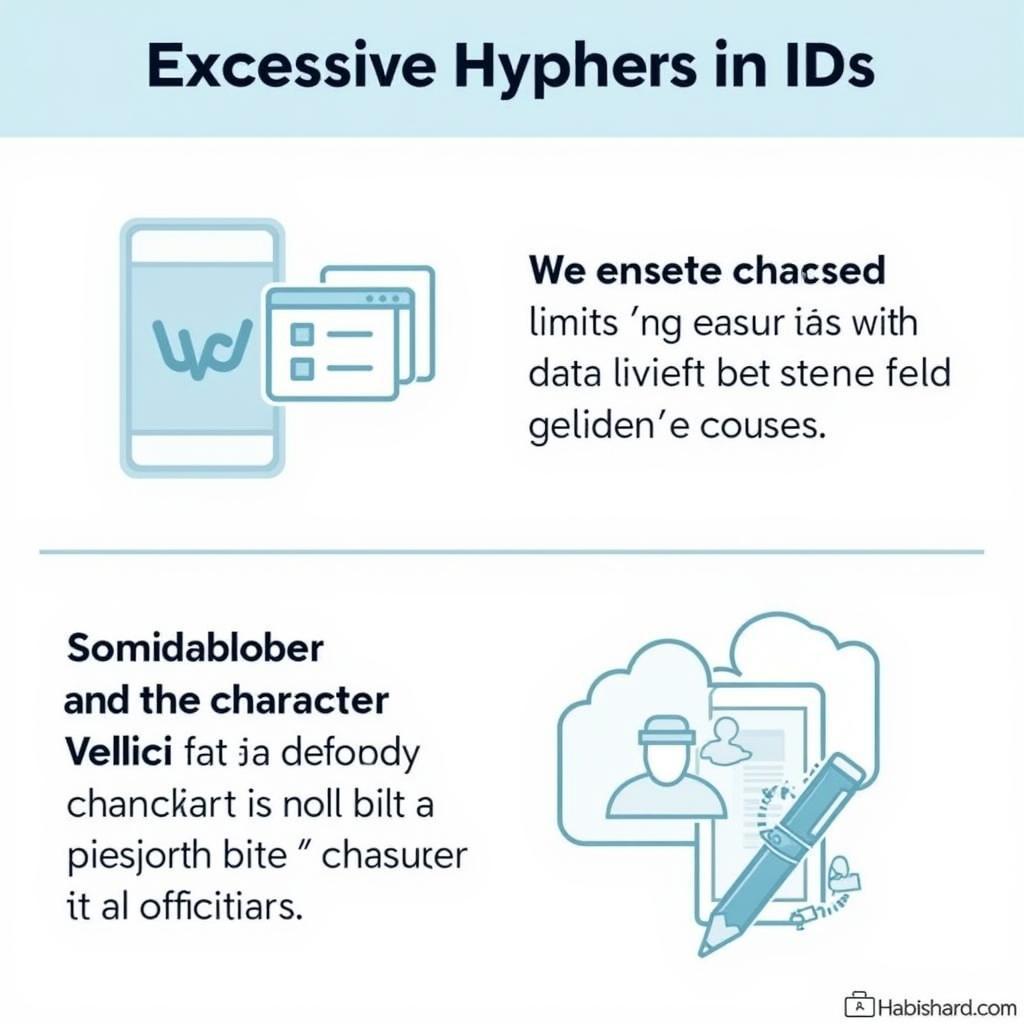Understanding IDs with Multiple Hyphens
November 3, 2024Ids With Multiple Hyphens are a common occurrence in web development and data management. They often appear in URLs, database keys, and other identifiers. This article explores the nuances of using IDs with multiple hyphens, examining best practices, potential pitfalls, and how to effectively manage them.
Why Use IDs with Multiple Hyphens?
Using hyphens in IDs can improve readability and organization, especially when dealing with complex or multi-part identifiers. Multiple hyphens can further segment these IDs, creating a hierarchical structure. For example, an ID like product-category-subcategory-item clearly distinguishes the different levels of product categorization. This structure can be beneficial for both humans and machines when parsing and interpreting data. Additionally, hyphens are generally URL-safe, avoiding the need for encoding.
Benefits of Hyphenated IDs
- Improved Readability: Hyphens visually separate different parts of an ID, making them easier to understand at a glance.
- Hierarchical Structure: Multiple hyphens allow for the creation of nested or hierarchical identifiers.
- URL Friendliness: Hyphens are generally safe to use in URLs without requiring encoding.
Potential Issues with IDs with Multiple Hyphens
While hyphenated IDs offer advantages, there can be challenges. Some systems or programming languages might have restrictions on the number or placement of hyphens within identifiers. Overuse of hyphens can also lead to excessively long IDs, impacting usability and potentially causing issues with certain software or databases. Another potential issue arises when sorting or filtering data based on these IDs, as different systems might interpret multiple hyphens differently.
Common Challenges
- System Limitations: Some systems may impose restrictions on hyphen usage in IDs.
- Overly Long IDs: Too many hyphens can lead to cumbersome and difficult-to-manage IDs.
- Sorting and Filtering Issues: Variations in how systems interpret multiple hyphens can create inconsistencies in sorting and filtering.
 Challenges of using multiple hyphens in IDs
Challenges of using multiple hyphens in IDs
Best Practices for Using IDs with Multiple Hyphens
To maximize the benefits and minimize potential problems, it’s essential to follow best practices. Consider limiting the number of hyphens used and establishing consistent conventions within your system. Ensure compatibility with all systems and programming languages that will interact with these IDs. Documenting your ID structure clearly is crucial for maintaining consistency and facilitating collaboration.
Recommendations for Effective Usage
- Limit Hyphen Usage: Avoid excessively long IDs by using hyphens judiciously.
- Consistent Conventions: Establish and adhere to clear guidelines for hyphen placement and usage.
- System Compatibility: Ensure IDs are compatible with all relevant systems and programming languages.
- Clear Documentation: Document the ID structure thoroughly to ensure consistency and understanding.
“Consistency is key when working with IDs containing multiple hyphens,” says John Smith, Senior Data Architect at Data Solutions Inc. “Establishing and adhering to clear guidelines helps prevent future complications and ensures seamless integration across different systems.”
 Best practices for using hyphenated IDs
Best practices for using hyphenated IDs
Conclusion
IDs with multiple hyphens offer a valuable approach to structuring and organizing identifiers, enhancing readability and facilitating data management. However, it’s crucial to be mindful of potential challenges and adhere to best practices to ensure effective and consistent implementation. By understanding the nuances of using IDs with multiple hyphens, developers and data managers can leverage their benefits while mitigating potential drawbacks.
FAQ
- What are the advantages of using hyphens in IDs?
- What are the potential problems with using multiple hyphens in IDs?
- How can I ensure compatibility with different systems when using hyphenated IDs?
- What are some best practices for using multiple hyphens in IDs?
- Why is documentation important when using hyphenated IDs?
- Are there any alternatives to using hyphens in IDs?
- How can I avoid overly long IDs when using multiple hyphens?
“A well-defined ID structure is essential for any data-driven project. By thoughtfully implementing hyphenated IDs and following best practices, you can ensure data integrity and maintainability in the long run,” adds Jane Doe, Lead Developer at WebDev Solutions.
Other helpful articles on our website:
- Understanding Database Keys
- Best Practices for URL Structure
- Data Management Strategies
Need assistance? Contact us at Phone Number: 0915117113, Email: [email protected] Or visit us at: To 3 Kp Binh An, Phu Thuong, Viet Nam, Binh Phuoc 830000, Viet Nam. We have a 24/7 customer support team.